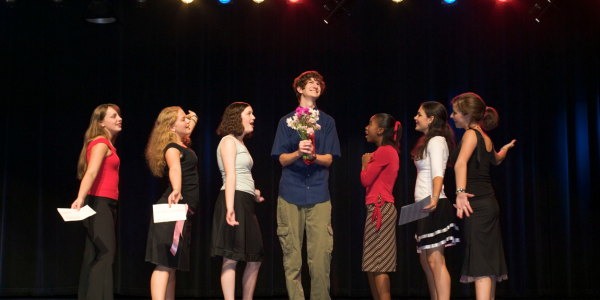19 September 2023
How to win the UIL One-Act Play contest (from a State Champion!)
Missey Head
Education Consultant and Former Fine Arts Teacher
In this blog, University Interscholastic League One-Act Play Contest State Champion Missey Head (Education Consultant and former Fine Arts Teacher) breaks down the step-by-step process she followed to win...
The University Interscholastic League One-Act Play Contest, founded in 1927, is the world's largest high school play competition, involving over 14,000 Texas students in 1,200+ plays across 300+ contests each spring. Supported by 300+ adjudicators, the contest has shaped educational and community theatre in Texas and is now inspiring similar competitions nationwide.
Theatre classes are now a staple in schools, with many employing multiple directors specializing in acting or technical theatre. During my tenure, my students advanced to the state competition 12 times, winning in 2011 and placing in the top three six times. Our success stemmed from a structured approach to script analysis, ensuring a deep understanding of the production process.
How to win a One-Act Play contest:
- Analyze your chosen script
- Learn from the play - and the playwright
- Watch as many productions as possible
- Finish the off-screen story
- Rehearse, rehearse, rehearse!
Analyze your chosen script (Time: 3-4 Days)
The script is the best place to start your research to better understand the play.
Start with a zero-pressure, zero-stress reading of the script. This should be purely for enjoyment, and should take around one day. I like to record the initial reaction to the play after this first reading.
Explore the DT+ Are you teaching script analysis handbook!
After this, you can begin to discuss and re-read the script. Analyzing the script creates a blueprint intended to provide directors, actors, designers, and technicians an opportunity to share a clear understanding and vision moving forward into the preparation, design, and implementation.
Here are some places to start with script analysis:
- Identify the play's structure and style
- Determine the prevailing mood and tone
- Make note of vocabulary, terms, concepts, tools, cultures, manners, historical events, fashion, music, lighting, scenery, props, or special effects that might require further investigation and research into
- Have the students and director collaborate and divide the play into 'units' or 'events', and ask them to come up with a descriptive title and mood for each one. This provides additional insight and context for the actor, director, and designer, and establishes a clear process for exploring the script.
Learn from the play - and the playwright (Time: 2 Weeks)
Table Work is critical to the production process, because it ensures that there is a collective understanding of the play.
During this time, my students and I were working on our production of All My Sons, and I assigned a different research topic(s) to each student - topics included the playwright's life and times, common themes and motifs, directing, lighting, costuming, scenery, props, marketing, and sound.
We relied heavily upon DT+ resources to help with this week-long research project.
A couple of my top recommendations are the All My Sons Study Guide, the 1987 BBC interviews with Arthur Miller, crew interviews like On Lighting Design with Natasha Chivers or On Costume with Faye Michel, and this episode of Collaborating on Sound and Music!
Face to Face: Arthur Miller - BBC (1995)
Students will then present their research using a shared PowerPoint (or similar!). Keeping the research in one shared file or presentation is essential for access and archival processes.
Be sure to set clear guidelines for these presentations - what format would you like them to be in? Would you prefer students to use a specific platform? How many slides are required per topic?
You can also set guidelines for what slides should contain in terms of visuals, media, and documentation of sources.
Note: If we run out of time, the remaining presentations can be presented outside of this week!
Watch as many productions as possible (Time: 1 Day)
If available, watch and discuss the digital version of the production. It's totally ok for students to watch a digital version or production of the play, so long as they understand the content is available to inform, not influence.
While watching the play, review the units and beats determined during your script analysis, and make any necessary edits as a group.
Cast of All My Sons | Digital Theatre+ | © Nobby Clarke
Finish the off-screen story (Time: Ongoing)
While watching productions and reading the script, I recommend that you also make a list of key scenes or events that we never see in the play.
What happens to the characters beyond what we see on the stage?
- List the scenes/events we never see
- Discuss the impact of these scenes/events on the characters and story
- Improve these scenes over a period of time and before rehearsal to develop further understanding of the character and story
Rehearse, rehearse, rehearse! (Time: Ongoing)
I recommend rehearsing the play by units or events. Prior to each unit, review the following:
- Descriptive title of the unit or event
- Mood of the unit or event
- Where does this unit or event land within the structure (Exposition, Rising Action, Inciting Action, Climax, Resolution)?
- Character obstacles, objectives, and tactics
A final note from Missey Head...
When I first began teaching, I completed and shared all the production research myself. Eventually, I realized that student engagement and learning increased when the sole responsibility for collecting and presenting the research depended upon the students.
After all, students won't always have the benefit of someone else doing all the work. I explained to them, "I want you to teach the play to ME. Hopefully, by teaching YOU this process, I will teach MYSELF out of a job!"! To all of you - good luck with your One-Act Play entries!
Related blogs
Core Skills: Development and Assessment
The first step to creating a rigorous and relevant curriculum is to determine the knowledge and...
Read moreThe key 21st Century Skills to help students thrive
21st Century Skills. Future Readiness. Life Skills. Global Citizenship. The Four Cs. Higher Order...
Read moreHow Digital Theatre+ Supports Your Seal of Fine Arts
In schools across the US, students are discovering a passion for the arts as they work towards...
Read moreGet the latest teaching tips straight to your inbox
Explore free lesson ideas and inspiration, education news, teaching trends and much more by signing up to regular blog updates!








